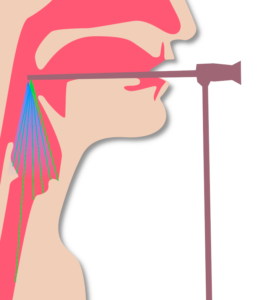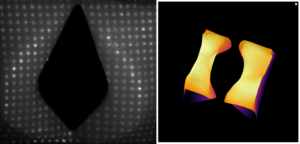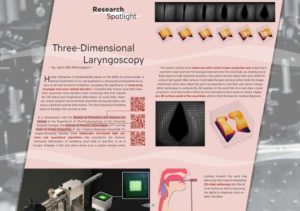3D Laryngoscopy
Human interaction is fundamentally based on the ability to communicate. A lasting impairment of our oral expression is necessarily accompanied by severe social and economic limitations, increasing the significance of diagnosing laryngeal and voice-related disorders. Conventionally, human vocal folds have been examined using standard video endoscopy that only regards the 2D lateral and longitudinal deformation of vocal folds. However, recent research has found that vocal folds during phonation also have a significant vertical deformation. This third dimension therefore needs to be taken into account as well.
I n a collaboration between the Division of Phoniatrics and Pediatric Audiology at the Department of Otorhinolaryngology of the University Hospital Erlangen, the Institute of Photonic Technologies (LPT) and the
n a collaboration between the Division of Phoniatrics and Pediatric Audiology at the Department of Otorhinolaryngology of the University Hospital Erlangen, the Institute of Photonic Technologies (LPT) and the
Chair of Visual Computing of the Friedrich-Alexander-Universität Erlangen-Nürnberg we develop novel endoscopic structured light systems and specialized algorithms that reconstruct the three-dimensional deformation of oscillating vocal folds in real-time. In all of Europe, Erlangen is the only place where such a system already exists.
 The system consists of an endoscope with a built-in laser projection unit, projecting a symmetric laser grid into the laryngeal area and onto the vocal folds. As vibrating vocal folds require a high temporal resolution, the system records videos with up to 4000 Hz using a high-speed video camera. We estimate the laser points position inside the image, determine which laser beam the point corresponds to, and then use stereo triangulation techniques to compute the 3D position on the vocal fold. In a next step, we fit a novel parametric vocal fold model into the estimated surface points to obtain a dynamic 3D surface model of the vocal folds, which is then the basis for medical diagnosis.
The system consists of an endoscope with a built-in laser projection unit, projecting a symmetric laser grid into the laryngeal area and onto the vocal folds. As vibrating vocal folds require a high temporal resolution, the system records videos with up to 4000 Hz using a high-speed video camera. We estimate the laser points position inside the image, determine which laser beam the point corresponds to, and then use stereo triangulation techniques to compute the 3D position on the vocal fold. In a next step, we fit a novel parametric vocal fold model into the estimated surface points to obtain a dynamic 3D surface model of the vocal folds, which is then the basis for medical diagnosis.
 Looking forward, we believe this work is taking a big step towards integrating 3D video endoscopy into the clinical routine as well as improving the ability to diagnose voice related disorders.
Looking forward, we believe this work is taking a big step towards integrating 3D video endoscopy into the clinical routine as well as improving the ability to diagnose voice related disorders.
by Jann-Ole Henningson

